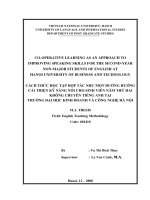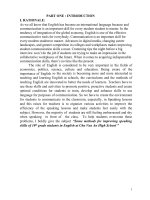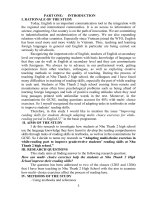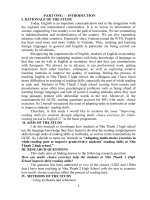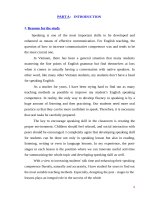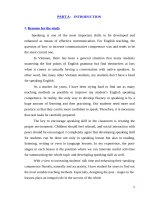SKKN IMPROVING SPEAKING SKILLS FOR RURAL STUDENTS THROUGH COLLABORATING WITH STUDENTS FROM OTHER COUNTRIES VIA SKYPE
Bạn đang xem bản rút gọn của tài liệu. Xem và tải ngay bản đầy đủ của tài liệu tại đây (2.4 MB, 27 trang )
SÁNG KIẾN KINH NGHIỆM
ĐỀ TÀI
IMPROVING SPEAKING SKILLS FOR RURAL STUDENTS THROUGH
COLLABORATING WITH STUDENTS FROM OTHER COUNTRIES VIA
SKYPE
MÔN: TIẾNG ANH
SỞ GIÁO DỤC VÀ ĐÀO TẠO NGHỆ AN
TRUNG TÂM GDNN- GDTX HUYỆN CON CUÔNG
----------
SÁNG KIẾN KINH NGHIỆM
ĐỀ TÀI
IMPROVING SPEAKING SKILLS FOR RURAL STUDENTS THROUGH
COLLABORATING WITH STUDENTS FROM OTHER COUNTRIES VIA
SKYPE
MÔN: TIẾNG ANH
Tác giả: Nguyễn Thị Trà Ly
Năm học : 2021 – 2022
Điện thoại : 0979079190
TABLE OF CONTENTS
PART I: INTRODUCTION ..................................................................................1
1. Rationale of the study ........................................................................................1
2. Aim of the study ................................................................................................1
3. Scope of the study .............................................................................................1
4. Objectives of the study ......................................................................................1
5. Method of the study: ..........................................................................................2
PART II: CONTENT ............................................................................................3
I. THEORETICAL BACKGROUND ...................................................................3
1. Skype in the classroom ......................................................................................3
1.1. Skype as a communication tool ......................................................................3
1.2. The main features of Skype in the classroom ................................................4
1.2.1. Mystery Skype .............................................................................................4
1.2.2. Virtual Field Trip .........................................................................................4
1.2.3. Guest Speaker ..............................................................................................4
1.2.4. Classroom to Classroom connection ...........................................................5
1.2.5. Skype collaboration .....................................................................................5
2. Speaking skills ...................................................................................................5
2.1. Definitions of speaking...................................................................................5
2.2. The elements of speaking ...............................................................................5
II. PRACTICAL BACKGROUND .......................................................................8
III.PRACTICAL APPLICATION IN USING SKYPE TO IMPROVE
STUDENTS’ SPEAKING SKILLS .....................................................................9
1. Mystery Skype ...................................................................................................9
2. Virtual Field Trips…………………………………………………………...12
3. Guest Speaker ……………………………………………………………….14
4. Classroom to Classroom connection ………………………………………..17
5. Skype collaborations ………………………………………………………..19
PART III: CONCLUSION
1. Results of the experience application ……………………………………….21
2. Recommendation…………………………………………………………….23
3. Suggestions for further study………………………………………………...23
REFERENCES…………………………………………………………………24
PART I: INTRODUCTION
1. Rationale of the study:
English is a compulsory subject in most of the schools in Vietnam. Because it
plays an important role in human beings’ life, especially, in social communications
and workplaces. According to foreign language competence framework for
Vietnamese students, high school graduated students are supposed to reach tertiary
level (equivalent to Level B1). To fluently communicate as expected, students have
to develop communicative skills including listening, speaking, reading, and
writing. However, language competence in every skill is under expected level
especially in speaking skill, which is clearer to realize for students in rural areas.
As a teacher of language for many years in Con Cuong which is located in a
mountainous area in Nghe An province, I myself find that one of the major reasons
why students are afraid of speaking English is lack of communicating
environment. Traditionally, students spend far too much time learning grammar,
which is designed to take up various tests at schools, so most of teachers focus on
teaching grammar for their students.
Besides, from the experience in teaching English to primary and secondary
school students who do not have so much interest in speaking as in classes of other
skills because they have difficulties in performing speaking tasks by themselves.
To solve these problems, I have tried many ways to help my students to improve
their speaking skills. I believe that online platforms are useful digital services,
which are used to support learning and teaching languages. Skype is the best
option we have chosen for my students in a small town.
2. Aims of the study:
The aim of this study is to show and prove that Skype, used as an
educational tool can be highly beneficial for foreign language learning, in this case
English. In fact, skype in the classroom creates many opportunities for English
teachers to effectively apply technology in teaching English, exchange teaching
methods and gain experiences from other teachers. Furthermore, it helps students
improve their speaking skill as well as listening and writing skills and motivate
students to speak English and connect with foreign students to exchange cultures
and knowledge.
3. Scope of the study:
- Applying in communicative lessons.
-Applying to held Speaking English Clubs and outside activities for students.
4. Objectives of the study:
- 6th and 7th graders at Chi Khe Secondary School and Boarding Secondary School
for Ethnic Minority Students , Con Cuong district, Nghe An province.
1
5. Method of the study:
- Studying materials about improving English speaking skills in reference books
and articles.
- Analyzing and drawing experiences from the process of carrying out.
- Finding suitable classes on teaching platforms on Facebooks, discussing with
other teachers about connecting contents.
- Applying common types of online platforms such as Zoom, Teams, Skype,
Google meet and others in the real working.
2
PART II: CONTENT
I. THEORETICAL BACKGROUND
1. Skype in the classroom
1.1. Skype as a communication tool
Skype is a voice communication tool that is available almost everywhere in
the world. It was invented by Scandinavian entrepreneurs Niklas Zennstrom and
Janus Friis. On 29 August 2003 the software application Skype was introduced to
the world. The project was initially named “Skype peer – to – peer” and morphed
into Skyper. Later the final letter r was dropped, and the title of the original
concept has become Skype. Throughout the years there have been several changes
to skype logo and it is now an icon that features the letter S that is white with a
blue background. The white colour of the logo represents harmony and peace while
the blue colour of the logo represents hope, prosperity and communications.
Teachers can use Skype to access and share activities, resources and lesson
plans, to connect to other educators and organizations, and to spark even more
ideas for using the instant messaging, voice and video calling for learning and
teaching. In the classroom, many teachers now have access to a projector, a
computer and an internet connection. Video calling is a great way to encourage
whole class interaction and participation in activities.
Like all technologies, using Skype will not magically improve teaching or
make lessons more compelling or memorable. Effective use of Skype is dependent
on the skill and imagination of the teacher. Connecting to educators who have
learnt what works well is a great way to develop confidence and share great advice
3
– on preparing for and framing activities, on running Skype sessions with learners,
and in getting the most out of these with follow up activities.
Modern Foreign Language teachers have long been aware of the power of
video calling to bring language learning to life for their students. Partnering with
other schools can enable all learners to broaden their horizons and knowledge,
across all subject areas, by working together, and through exploring and
understanding differences and similarities. Skype provides educators with a real
way to enable learners to not only ‘see in to’ other classrooms, countries and
cultures, but also to make meaningful connections through collaboration and
conversation.
1.2. The main features of Skype in the classroom.
Skype in the classroom offers five educational ways of learning: Mystery
Skype, Virtual Field Trips, Guest Speakers, Classroom to Classroom connection,
and Skype collaborations.
1.2.1. Mystery Skype
This feature is the global guessing game. Students can learn about
geography culture, and the similarities and differences of how children live all over
the world. It is an educational game with the aim to guess the location of the other
classroom. It is played by two or more classrooms on Skype and it is suitable for
all ages. By asking Yes/No questions, students can learn more about the global
community and they can effectively communicate. Usually, they provide clues to
each other. There are many versions for Mystery Skype such as Mystery Animals,
Mystery Locations, Mystery Numbers, Mystery Singers, etc. The game
incorporates communication and critical skills and, at the same time, it develops
creativity and collaboration.
1.2.2. Virtual Field Trips
Virtual field trips are learning excursions that happen online through video
conferencing software, livestream video, or digital map and photograph platforms.
For example, a virtual zoo tour or an online visit to the Great Wall of China.
Virtual field trip (VFT) are free and they are excellent for the students who attend
Primary or Secondary school to explore new places, meet different cultures and
people without leaving the classroom. To comprehend better, students should
prepare for the lecture, by providing more material about the topic that can be
reviewed after virtual trip. This type of class is always amusing for students and
they feel more motivated to learn.
1.2.3. Guest Speaker
Skype in the Classroom’s guest speakers can help bring learning to life for
your school’s students. Imagine this scenario, a couple of your classrooms are
studying Ancient Greece and to enrich the experience a guest speaker, located in
4
Ancient Corinth, Greece, speaks to the students, via Skype, about current
excavations and describes how Greece looked in antiquity compared to the present
day. And this is just one example. There are hundreds of volunteer guest speakers
from around the world that are available to speak to your classrooms via Skype.
These guest speakers are experts in every subject area you can imagine as they are
authors, scientists, engineers, zookeepers, etc. Getting them in front of students is a
snap as well.
1.2.4. Classroom to Classroom connection
A Skype lesson is a fantastic way to engage your whole class. Students can
be assigned different roles to keep everyone involved throughout the lesson. These
can include greeters, inquirers, sharers, researchers, photographers, bloggers,
timekeepers and scribes. A few other ideas that can work well when preparing for
your lesson include asking your class to come up with questions, and letting them
choose which to ask. Learners can also prepare presentations on the areas you
know will be covered in the lesson. A lot of teachers also find it helpful to set some
basic ground rules before a Skype call, especially if it’s the first time you’ll be
using it in your classroom. Classroom to Classroom interactions bring new joy to
students and encourage them to actively participate in discussions.
1.2.5. Skype collaboration
Connecting the classrooms the students can see the world from another
perspective and meet some unknown cultural and social norms. They can work on
projects, share their half via Skype and the other classroom presents the missing
half. It allows students to learn and meet people and explore cultures from all over
the world. By this feature, students build compassion, share knowledge, have fun
and empathy for one another. Students mostly work in groups and they are all
involved in the project. They have to work together and solve a problem. So, they
learn to respect each other, hear different opinions and by this method they develop
their social skills and learn from their peers at the same time. The collaborative
learning methodology is ideal for children that have difficulties in a social setting.
2. Speaking skills
2.1. Definitions of speaking
According to experts, there are various definitions of speaking. Hammer
(2007 :284) states that speaking is the ability to speak fluently and presupposes not
only knowledge features but also the ability to process information and language
“on the spot” while Quianthy (1990:7) defines speaking as the process of
transmitting ideas and information orally in variety of situations.
2.2. The elements of speaking
There are six components of speaking to be scored; pronunciation, grammar,
vocabulary, fluency, comprehension, and task as Brown (2004) has stated.
5
Pronunciation
V = equivalent to and fully accepted by educated native speaker
IV = errors in pronunciation are quite rare
III = errors never interfere with understanding and rarely disturb the native
speaker. Accent may be obviously foreign.
II = accent is intelligible though often quite faulty.
I = errors in pronunciation are frequent but can be understood by a native speaker
used to dealing with foreigners attempting to speak his language.
Grammar
V = equivalent to that of an educated native speaker.
IV = able to use the language accurately on all levels normally pertinent to
professional needs. errors in grammar are quite rare.
III = control of grammar is good. able to speak the language with sufficient
structural accuracy to participate effectively in most formal and informal
conversation on practical, social and professional topics.
II = can usually handle elementary constructions quite accurately but does not have
thorough or confident control of the grammar.
I = errors in grammar are frequent, but speaker can be understood by a native
speaker used to dealing with foreigners attempting to speak his language.
Vocabulary
V = speech on a levels is fully accepted by educated native speakers in all its
features including breadth of vocabulary and idioms, colloquialisms, and pertinent
cultural references.
IV = can understand and participate in any conversation within the range of his
experience with a high degree of precision of vocabulary.
III = able to speak the language with sufficient vocabulary to participate effectively
in most formal and informal conversations on practical, social, and professional
topics. Vocabulary is broad enough that he rarely has to grope for a word.
II = has speaking vocabulary sufficient to express himself simply with some
circumlocutions.
I = speaking vocabulary inadequate to express anything but the most elementary
needs.
Fluency
V = has complete fluency in the language such that his speech is fully accepted by
educated native speakers.
6
IV = able to use the language fluently on all levels normally pertinent to
professional needs. Can participate in any conversation within the range of this
experience with a high degree of fluency.
III = can discuss particular interest of competence with reasonable ease. Rarely has
to grope for words.
II = can handle with confidence but not with facility most social situations,
including introductions and casual conversations about current events, as well as
work, family and autobiographical information.
I = (no specific fluency description. Refer to other four language areas for implied
level of fluency.)
Comprehension
V = Equivalent to that of an educated native speaker.
IV = can understand any conversation within the range of his experience.
III = comprehension is quite complete at a normal rate of speech.
II = can get the gist of most conversation of non-technical subjects (i.e., topics that
require no specialized knowledge)
I = within the scope of his very limited language experience, can understand
simple questions and statements if delivered with slowed speech, repetition, or
paraphrase.
Task
V = speaking proficiency equivalent to that of an educated native speaker.
IV = would rarely be taken for a native speaker but can respond appropriately even
in unfamiliar situations. Can handle informal interpreting from and into language.
III = can participate effectively in most formal and informal conversations on
practical, social, and professional topics.
II = able to satisfy routine social demands and work requirement; needs help in
handling any complication or difficulties.
I = can ask and answer questions on topics very familiar to him. Able to satisfy
routine travel needs and minimum courtesy requirements.
According to Harris (1974) there are five components of speaking skill
concerned with comprehension, grammar, vocabulary, pronunciation, fluency.
a) Comprehension
For oral communication, it certainly requires a subject to respond, to speech as
well as to initiate it.
b) Grammar
7
It is needed for students to arrange a correct sentence in conversation. It is in line
with explanation suggested by Heaton (1978: 5) that students’ ability to manipulate
structure and to distinguish appropriate grammatical form in appropriateness. The
utility of grammar is also to learn the correct way to gain expertise in a language in
oral and written form.
c) Vocabulary
Vocabulary means the appropriate diction which is used in communication.
Without having a sufficient vocabulary, one cannot communicative effectively or
express their ideas both oral and written form. Having limited vocabulary is also a
barrier that precludes learners from learning a language. Without grammar very
little can be conveyed, without vocabulary nothing can be conveyed. So, based on
this explanation, the researcher 6 concluded that without mastering vocabulary
sufficiently is English learners will not be able to speak English or write English
properly.
d) Pronunciation
Pronunciation is the way for students‟ to produce clearer language when they
speak. It deals with the phonological process that refers to the component of a
grammar made up of the elements and principles that determine how sounds vary
and pattern in a language. There are two features of pronunciation; phonemes and
supra segmental features. In speaking, pronunciation plays a vital role in order to
make the process of communication easy to understand.
e) Fluency
Fluency is the ability to read, speak, or write easily, smoothly and expressively. In
other words, the speaker can read, understand and respond in a language clearly
and concisely while relating meaning and context. Fluency can be defined as the
ability to speak fluently and accurately.
II.PRACTICAL BACKGROUND
Nowadays, English as a means of communication and entertainment is no
longer strange to students, especially to those who live in big cities. Children are
sent to English centres to learn with native teachers at a very young age. However,
students in my town do not have any opportunities to speak with foreigners
because my town is small and far from big cities. Furthermore, there have not had
English centres for many years. Most of students are not confident when they
speak English or give their own opinions.
To motivate students speaking confidently or naturally, I ask students to
speak a lot, do role play and record videos to practice more and more.I always
change my teaching methods to be suitable for my students in different situations.
And I usually search educational information to adapt my lesson plans on the
internet, join in many groups of innovation teachers. Then I found that skype is the
8
best way to use English in a real-life situation and I think it is worth much more
than just another worksheet.
III. PRACTICAL APPLICATION IN USING SKYPE TO IMPROVE
STUDENTS’ SPEAKING SKILLS.
I have used skype in the classroom since 2017. After connecting with many
teachers and students from different countries, I believe that skype is a useful tool
in teaching and learning languages. Below are the activities which were completed
at school.
1. Mystery Skype
- The global guessing game helps kids learn about geography, culture, and the
similarities and differences of how children live all over the world.
- Play Mystery Skype with a class from Israel
9
- Play Mystery skype with a class from India
- Play Mystery Skype with a class from Turkey
10
- Play Mystery skype with classes from Brazil
and from Canada
- Play Mystery Skype with classes from the USA
11
2.Virtual Field Trips
- We met a teacher from India to visit the Dinosaur museum.
- To celebrate Earth Day, my students had a chance to travel the USA farm to learn
about animals. They knew how to feed the animals and love animals so much.
12
- My students joined in the Virtual Field Trip "Meet a Penguin and learn about
EarthDay".
13
3. Guest Speaker
- We invited teacher Mohammed from Egypt, he introduced his country and
language.
- My students met a special guest speaker, who talked about his country from
Serbia
14
-We invited a teacher from Brazil to talk about her country.
- We invited teachers from Russia as Guest Speakers to introduce their country and
talk about their cultures.
15
- We had a wonderful Skype session with American Katherine Petrole based at
Corinth Greece, we were grateful to Katherine Petrole for accepting our request as
Guest Speaker, Katherine Petrole is Museum professional and lifelong learner with
nine years of museum experience. She has managed collections of over 300,000
objects and records.
Current Country: Greece
Location: Ancient Corinth, Greece
- To celebrate WRAD (World Read Aloud Day), my students connected the writer
Lisa who is from the USA to learn how to write a story and she introduced her
novels.
16
4.Classroom to Classroom connection
Using Skype in the classroom helps us connect many countries all over the
world. We have created many English lessons for our students to learn and
exchange their knowledge. A few years ago, I connected with many classes from
Egypt, Japan, the USA, India, Sweden, Germany, Cyprus, France, etc. These are
pictures that we took when we completed classroom to classroom connection.
- A class from Cyprus
- A class from Japan
17
- Classes from European countries
18
5. Skype collaborations
- Connect with other educators and classes around the world and collaborate on
specific projects such as traditional holidays, International Peace Day, Earth Day,
Ocean Day, World Read Aloud Day and European Language Day.
19
20
PART III: CONCLUSION
1.Results of the experience application
Skype not only have helped my students meet a lot of friends, improve their
speaking skill and motivate my students speak English in natural way, but also
help me receive the gift from Microsoft Education Community in my country.
Students learnt the cultures,languages, and customs of a lot of countries.
Furthermore, they are more confident to speak English with foreigners and express
their thoughts at school and their community.Using Skype in the classroom
bringsme a lot of friends around the world and students to become global citizens.
21
22

